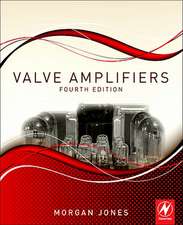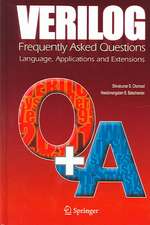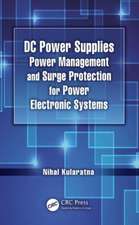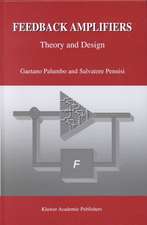Liquid Crystal Display Drivers: Techniques and Circuits
Autor David J.R. Cristaldi, Salvatore Pennisi, Francesco Pulvirentien Limba Engleză Paperback – 19 oct 2010
| Toate formatele și edițiile | Preț | Express |
|---|---|---|
| Paperback (1) | 630.60 lei 6-8 săpt. | |
| SPRINGER NETHERLANDS – 19 oct 2010 | 630.60 lei 6-8 săpt. | |
| Hardback (1) | 640.55 lei 6-8 săpt. | |
| SPRINGER NETHERLANDS – 8 apr 2009 | 640.55 lei 6-8 săpt. |
Preț: 630.60 lei
Preț vechi: 741.88 lei
-15% Nou
Puncte Express: 946
Preț estimativ în valută:
120.74€ • 125.73$ • 100.18£
120.74€ • 125.73$ • 100.18£
Carte tipărită la comandă
Livrare economică 12-26 februarie
Preluare comenzi: 021 569.72.76
Specificații
ISBN-13: 9789048184828
ISBN-10: 9048184827
Pagini: 316
Ilustrații: XVIII, 295 p.
Dimensiuni: 155 x 235 x 17 mm
Greutate: 0.45 kg
Ediția:Softcover reprint of hardcover 1st ed. 2009
Editura: SPRINGER NETHERLANDS
Colecția Springer
Locul publicării:Dordrecht, Netherlands
ISBN-10: 9048184827
Pagini: 316
Ilustrații: XVIII, 295 p.
Dimensiuni: 155 x 235 x 17 mm
Greutate: 0.45 kg
Ediția:Softcover reprint of hardcover 1st ed. 2009
Editura: SPRINGER NETHERLANDS
Colecția Springer
Locul publicării:Dordrecht, Netherlands
Public țintă
ResearchCuprins
Liquid Crystals.- Liquid Crystal Displays.- Passive LCDs and Their Addressing Techniques.- Drivers for Passive-Matrix LCDs.- Active Matrix LCDs and Their Addressing Techniques.- Drivers for Active-Matrix LCDs.- Charge Pumps for LCD Drivers.
Notă biografică
David Joseph Roger Cristaldi graduated in Electronics Engineering at the University of Catania in 2005. In his thesis, developed at STMicroelectronics, he studied low-power design methodologies for liquid crystal display drivers. In 2006 he obtained the Italian qualification for the engineer profession and in the same year he was admitted to the Ph.D. course in Electronics Engineering, Automation Engineering, and Control of Complex Systems. His current research activity concerns analysis and modeling of electromagnetic-interference effects on Sigma-Delta analog-to-digital converters. Dr. Cristaldi received the Ph.D. degree in 2009.
Salvatore Pennisi received the laurea degree in electronic engineering in 1992 and the Ph.D. degree in electrical engineering in 1997, both from the University of Catania. He joined in 1996 the Department of Electrical Electronics and Systems Engineering (DIEES), University of Catania, as an Assistant Professor and he was appointed an Associate Professor in 2002. Since then, he has been engaged in scientific projects in collaboration with national and international academic and industrial partners. His main research interests include circuit theory and analog design with emphasis on low-voltage and current-mode techniques. In this field, he has developed several building blocks and unconventional architectures of operational amplifiers. More recently, his research activities have involved multi-stage amplifiers with related frequency compensation, data converters and the analysis of high-frequency distortion in analog circuits such as feedback amplifiers, oscillators and filters. He published over 60 papers in international journals and more than 120 contributions in conference proceedings, he is the co-author of the books CMOS Current Amplifiers (1999) and Feedback Amplifiers: Theory and Design (2001), both edited by Kluwer Academic Publishers, and has written an entry in the Wiley Encyclopedia of Electrical and Electronics Engineering. Dr. Pennisi is senior member of the IEEE since 2004 and is a member of the IEEE CAS Analog Signal Processing Technical Committee. He currently serves as an Associate Editor of the IEEE Transactions on Circuits and Systems-Part II: Express Briefs.
Francesco Pulvirenti graduated in Electronic Engineering at the University of Pisa, Italy, in 1989. After the military service, he joined STMicroelectronics, Castelletto (Milan) site, in 1991 and then he moved to Catania site in 1993. He started working in the Industrial and Peripheral Division developing Smart Power ICs for Industrial Applications, Linear Regulators, Switching Mode Power Supply and Power Management for Industrial, Mobile Phone, Battery Charger and Computer Applications. In 2001 he moved to Display segment to manage the design of new Drivers dedicated to Liquid Crystal Display Applications for portable equipments and in 2004 he was appointed Design Director of the Display Division. Since 2007 he is working in the Industrial and Power Conversion Division to define and develop new products for Photovoltaic Applications and he is currently managing a team of about 30 people as Business Unit Director. Francesco Pulvirenti holds 32 patents on Analog and Smart Power ICs in the USA, he has 4 patents pending and he is also author or co-author of 8 papers on full custom ICs.
Salvatore Pennisi received the laurea degree in electronic engineering in 1992 and the Ph.D. degree in electrical engineering in 1997, both from the University of Catania. He joined in 1996 the Department of Electrical Electronics and Systems Engineering (DIEES), University of Catania, as an Assistant Professor and he was appointed an Associate Professor in 2002. Since then, he has been engaged in scientific projects in collaboration with national and international academic and industrial partners. His main research interests include circuit theory and analog design with emphasis on low-voltage and current-mode techniques. In this field, he has developed several building blocks and unconventional architectures of operational amplifiers. More recently, his research activities have involved multi-stage amplifiers with related frequency compensation, data converters and the analysis of high-frequency distortion in analog circuits such as feedback amplifiers, oscillators and filters. He published over 60 papers in international journals and more than 120 contributions in conference proceedings, he is the co-author of the books CMOS Current Amplifiers (1999) and Feedback Amplifiers: Theory and Design (2001), both edited by Kluwer Academic Publishers, and has written an entry in the Wiley Encyclopedia of Electrical and Electronics Engineering. Dr. Pennisi is senior member of the IEEE since 2004 and is a member of the IEEE CAS Analog Signal Processing Technical Committee. He currently serves as an Associate Editor of the IEEE Transactions on Circuits and Systems-Part II: Express Briefs.
Francesco Pulvirenti graduated in Electronic Engineering at the University of Pisa, Italy, in 1989. After the military service, he joined STMicroelectronics, Castelletto (Milan) site, in 1991 and then he moved to Catania site in 1993. He started working in the Industrial and Peripheral Division developing Smart Power ICs for Industrial Applications, Linear Regulators, Switching Mode Power Supply and Power Management for Industrial, Mobile Phone, Battery Charger and Computer Applications. In 2001 he moved to Display segment to manage the design of new Drivers dedicated to Liquid Crystal Display Applications for portable equipments and in 2004 he was appointed Design Director of the Display Division. Since 2007 he is working in the Industrial and Power Conversion Division to define and develop new products for Photovoltaic Applications and he is currently managing a team of about 30 people as Business Unit Director. Francesco Pulvirenti holds 32 patents on Analog and Smart Power ICs in the USA, he has 4 patents pending and he is also author or co-author of 8 papers on full custom ICs.
Textul de pe ultima copertă
Liquid Crystal Display Drivers deals with Liquid Crystal Displays from the electronic engineering point of view and is the first expressively focused on their driving circuits. After introducing the physical-chemical properties of the LC substances, their evolution and application to LCDs, the book converges to the examination and in-depth explanation of those reliable techniques, architectures, and design solutions amenable to efficiently design drivers for passive-matrix and active-matrix LCDs, both for small size and large size panels. Practical approaches regularly adopted for mass production but also emerging ones are discussed. The topics treated have in many cases general validity and found application also in alternative display technologies (OLEDs, Electrophoretic Displays, etc.).
Liquid Crystal Display Drivers is not only a reference for engineers and system integrators, but it is written also for scientific researchers, educators and students. It is a valuable resource for advanced undergraduate and graduate students attending display systems courses, and it may prove attractive even for a non-expert in the field, as it is reasonably simply written and reach of illustrations and many interesting details (the men and the ideas behind the things they produced were also put in evidence).
Liquid Crystal Display Drivers is not only a reference for engineers and system integrators, but it is written also for scientific researchers, educators and students. It is a valuable resource for advanced undergraduate and graduate students attending display systems courses, and it may prove attractive even for a non-expert in the field, as it is reasonably simply written and reach of illustrations and many interesting details (the men and the ideas behind the things they produced were also put in evidence).
Caracteristici
The only one expressly written by and for electronic engineers The only one to cover all aspects of display driver circuits Presents up to date material while it is still in a period of development Comprehensive exposure of the technology, architectures and design techniques






















